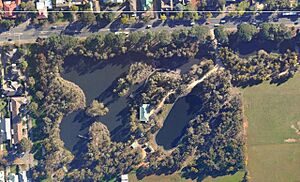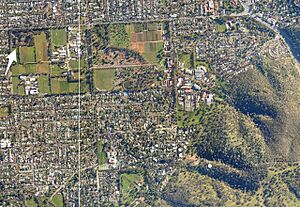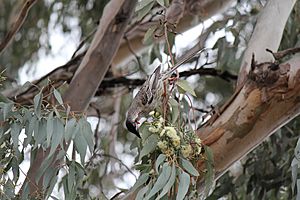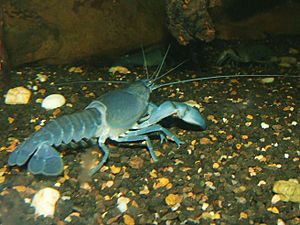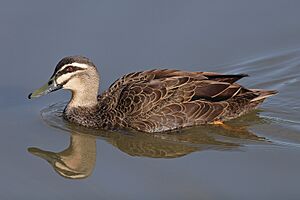Urrbrae Wetland facts for kids
The Urrbrae Wetland is a special place in Urrbrae, a suburb of Adelaide. It's a human-made wetland built to help manage floodwaters coming from the nearby Adelaide Hills. This amazing area also provides great benefits for nature and learning. The wetland covers about 6 hectares, which is like 15 football fields! It's located on the grounds of Urrbrae Agricultural High School. The water part is about 4 hectares and can hold around 13.5 million litres of water when full.
Contents
How the Wetland Works
The Urrbrae Wetland has four main water areas. There's a large main pond, two smaller ponds for cleaning, and a farm dam. The main pond has a clay base to stop water from leaking out. The farm dam has a special lining and is used to add water to the main pond if it gets too low.
Every year, about 400 million litres of stormwater flow through the wetland. This water comes from a large area of about 380 hectares. The wetland helps clean this stormwater using natural processes:
- The water slows down as it moves through the wetland.
- Sand and other bits of dirt sink to the bottom.
- Harmful things like heavy metals and salts stick to these sinking particles.
- Plants like reeds and sedges growing along the edges filter out more salts and metals.
Special systems at the start of the cleaning ponds remove leaves, plastic bags, and other rubbish. After being cleaned, the water flows through pipes to Brown Hill Creek and then out to the sea. The City of Mitcham council helps manage this process. Since 2011, some of the cleaned water is also pumped to tanks at the High School. This water is then used to water the school grounds during the dry summer months.
How the Wetland Started
In 1993, both the City of Mitcham council and the Urrbrae Agricultural High School were looking into creating a wetland. The council wanted to solve a long-standing flooding problem in the area. The school also had issues with flooding on its farmland. Plus, they wanted to offer more environmental studies to their students.
Work on building the Urrbrae water storage area began in June 1996 and finished in December 1996. It cost $1.2 million, with money from the City of Mitcham, the SA Department of Transport, and the Patawalonga Catchment Water Management Board. The land itself was given by Peter Waite, a generous person from the early 1900s, specifically for educational use.
In 1997, a group called "The Friends of the Urrbrae Wetland" was formed. They are sponsored by the Rotary Club, Mitcham. This group's main goal is to plant native trees and plants that grew in the area before European settlement. This type of forest is called grey box woodland. The Friends meet every week to help improve the environment by planting new trees and removing weeds.
Plants and Animals of the Wetland
Plants
The Urrbrae Wetland is home to many native plants. The main type of plant community here is called grey box woodland. This kind of woodland is now considered 'threatened' by the Australian Government.
Grey Box Woodland
The grey box woodland gets its name from the Eucalyptus microcarpa tree, which is commonly called "grey box" because of its bark. These trees used to be very common on the southern Adelaide Plains. Over the years, the Friends of the Urrbrae Wetland have planted over one hundred different native plant species. This helps create a diverse habitat for animals and provides plants for other planting projects.
Some of the plants you can find here include:
- Tall trees: Grey box, river red gum, South Australian blue gum, and drooping sheoak.
- Shrubs: Five different types of wattles (acacias), sweet bursaria, and sticky hop bush.
- Ground plants: Several types of saltbush, eutaxia, vittadinia daisies, lilies, and many native grasses.
Aquatic Animals
The water in the wetland is home to many interesting creatures. You can find four different types of frogs here. There are also over fifty kinds of small water insects and other invertebrates. Fish like the Murray River rainbowfish swim in the ponds. You might also spot a common yabby, which is a type of freshwater crayfish.
Birds
The Urrbrae Wetland has water all year round, which makes it a perfect home for many waterbirds. They also find plenty of food here. You can often see Pacific black ducks, Australian wood ducks, Australasian grebes, and Eurasian coots. Sometimes, rarer birds like the sacred kingfisher and the little lorikeet visit.
As the native trees and plants grow, more bush birds are also coming to the wetland. When the eucalyptus trees are flowering, you might see New Holland honeyeaters, musk lorikeets, and rainbow lorikeets. Many bird species also build their nests and raise their young at the wetland. These include the dusky moorhen, Eurasian coot, Australasian grebe, clamorous reed warbler, magpie-lark, willie wagtail, crested pigeon, and spotted turtle dove.
Learning at the Wetland
School and College Education
The wetland has a special classroom with lab equipment and visual aids. This makes it a great learning center for students from Urrbrae Agricultural High School and TAFE (Technical and Further Education) colleges. The school even has a Science Teacher-Manager who works at the wetland full-time. Other schools and community groups also visit the center to learn about wetlands. Each year, about 10,000 students come to explore and learn at the Urrbrae Wetland.
Community Education
The Friends of the Urrbrae Wetland group hosts two Open Days each year. On these days, the public is invited to come for a talk and a guided walk around the wetland. A big part of these events is learning about the important work of bringing back the Grey Box Woodland.
34°57′56″S 138°37′11″E / 34.965440°S 138.619760°E


